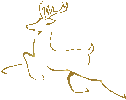
In the three days preceding the Samhain, the God of Light Lugh, dies
at the hand of his Tanist, who is
himself as the Lord of mis-rule. Lugh then passes through the veil
between the worlds on Samhain.
The Tanist is a stingy and harsh King who while shining brightly in
the skies gives no warmth to the
land. He cannot warm the north wind which is the breath of the Crone,
Cailleach Bheare. This is
indicative of the cyclic harmony of seasonal dominance which teaches
us that neither Life nor Death
can ever hold permanent sway.
Death was never far from our ancestors, and there was not the fear of
it that permeates the society
we live in. Yet while death itself wasn’t feared, it was held important
to die with honor. Through
dying well, people had the promise of living on in this world through
their clan and at “Fleadh nan
Mairbh” (Feast of the Dead). It is at this time the ancestors were
honored and the dead were
remembered. This feast took place on Samhain Eve. In many ways it is
very similar to the Mexican
"Day of the Dead.”
This is one of two times in the year when the veil between this world
and Otherworld, the Shield of
Skathach, is at it’s thinnest. For this reason it was a time of divination.
This day was considered to be
a day that did not exist. Because of this the Spirits of the Dead and
those yet to be born of the clan
walked freely amongst the living. Food and entertainment were provided
in their honour. In this way
the clan remained in unity with its past, present and future. The common
modern practice of carving
pumpkins in the States, and turnips in the old countries stem from
the days when our ancestors were
active head hunters. They believed that the spirit resided in the head.
They also believed that if they
controlled the head of a foe they had killed in battle, and displayed
the head at Samhain, then that foe
could do them no further ill during this time when they could again
walk in this realm. This practice
was modified in the times after the rise of Christianity. It was however
remolded into the practice of
carving vegetables with the same intent. That being to keep away harm
intending spirits.
Samhain was a time of fairs and festivities. As with all the fire festivals,
fires were lit on the hilltops at
Samhain. This festival was one of the two when all hearth fires were
extinguished and re-lit from the
communal bonfires. The cattle were driven back from the mountains where
they had been sent for the
summer. At this time of their return they were driven between two bonfires
to purify and protect
them. People and cattle both had now returned from the hills and glens
to their winter quarters and
were engaged in actively re-tying the social bonds. Just prior to this,
the stores that had been put up
had been assessed. Part of this assessment was how many could be fed
during the cold months
ahead. Rather than have whole herds starve to death in the winter,
the herds were culled and the
weakest harvested and the meat was preserved. The taking of life was
done in a sacred way, and the
utilitarian killing of the excess livestock had a sacrificial nature.
Another area were the religious
philosophy is addressed was in the bonds of kinship which were renewed
in the clan spirit that was
invoked at this time of year. Traditionally Samhain begins the time
of storytelling by the fires of the
hearth, as there isn’t much to do outside during this “time of the
little sun.”
Fiona